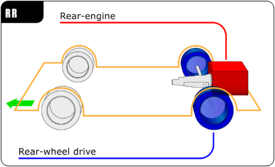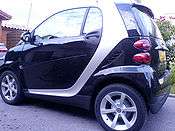Rear-engine design
In automobile design, a rear-engine design layout places the engine at the rear of the vehicle. The center of gravity of the engine itself is past the rear axle. This is not to be confused with the center of gravity of the whole vehicle, as an imbalance of such proportions would make it impossible to keep the front wheels on the ground.

Rear-engined cars are almost always rear wheel drive, a layout known as RR. The exception is certain high performance four wheel drive models from the German automaker Porsche. This layout is chosen for three reasons - packaging, traction, and ease of manufacture:
- Since the engine is located at an extremity, the rest of the vehicle can be used for passengers and luggage.
- Having the engine located over the driven wheels increases downward pressure, which is helpful for grip on loose surfaces.
- The drivetrain can be assembled as a unit and installed easily at the factory - easier than a front wheel drive layout where the driven wheels also steer the car.
A rear wheel drive, rear engine car tends to be prone to oversteer which allows for tighter turner radius than that of a neutral or understeer condition of a vehicle, however this causes vehicle instability. For this reason rear engine has been abandoned as a design option for regular passenger cars, but still maintains a viability for race applications.[1]
Although this layout was once popular, it was mainly found in small, inexpensive cars and light commercial vehicles. Most car makers have abandoned the rear-engined layout apart from Porsche who has gradually developed their design with improvements to the suspension and chassis to reduce the shortcomings of the layout to exceptional levels in road and race cars.
The most popular current application of this layout is in low-floor buses where its space-saving attributes are best applied.
On the DeLorean DMC-12, to compensate for the uneven (35/65) weight distribution caused by the rear-mounted engine, the car had rear wheels with a diameter slightly greater than the front wheels.
Notable rear-engined cars

- Benz Patent-Motorwagen
- BMW 600 and 700
- Chevrolet Corvair
- Davrian
- DeLorean DMC-12
- Dune buggies such as the Meyers Manx
- Fiat 500, 600, 850, 126 and 133
- FMR Tg500
- Hillman Imp
- Mercedes-Benz 130/150/170H
- Messerschmitt KR200
- Mitsubishi i and iMiev
- NSU Prinz
- Porsche 356, 911 and 959
- Renault 4CV, Dauphine, Caravelle, R8, R10, Renault Floride and the 3rd generation Twingo
- Renault Alpine A106, A108, A110, A310 and GTA/A610
- Simca 1000
- Škoda 1000/1100MB,MBX, 100/110, 110R, 105/120/125, 130/135/136, Garde, Rapid
- Smart Fortwo and Roadster
- Stout Scarab
- Subaru 360
- Suzuki Fronte 360, Fronte 71 and 72, Fronte Coupé, Fronte LC20, Fronte 7-S / SS10 / SS20 and Cervo SS20 / SC100
- Tata Nano, Tata Pixel and Tata Magic Iris
- Tatra T77 / T87 / T97 / T603 / T613
- Tesla Model S
- Tucker Torpedo
- Volkswagen Beetle, type 3 'pontoon', Karmann Ghia and type 4 (411/412), as well as the VW Bus and type 181 'Thing'
- ZAZ Zaporozhets series.